It’s pretty hypocritical for me to complain about a lack of NASCAR racing in
December, given that I hardly ever watch races on television anymore,
preferring to see local short-trackers in person. Nevertheless, I have to
have something to complain about, right?
(Actually, here’s the warning to non-history-nerds that most of what follows
will be my rambling about the past . . . pretty distant past, at that.)
So, if I can’t be AT a race – and most of the indoor venues are a little far
away for me – my next-best-thing is to wander through the dusty past. If
you care to join me, let’s ramble.
Most NASCAR history nerds know that the latest-in-the-year Grand
National/Cup race ever run took place on December 29, 1963, at Savannah
Speedway in Georgia. The race wasn’t intended to run that late; it had
been postponed twice due to weather, and so Bill France & Co. apparently
hoped that the race would live up to its name – the Sunshine 200 – a
couple of days before New Year’s and gave it a go.
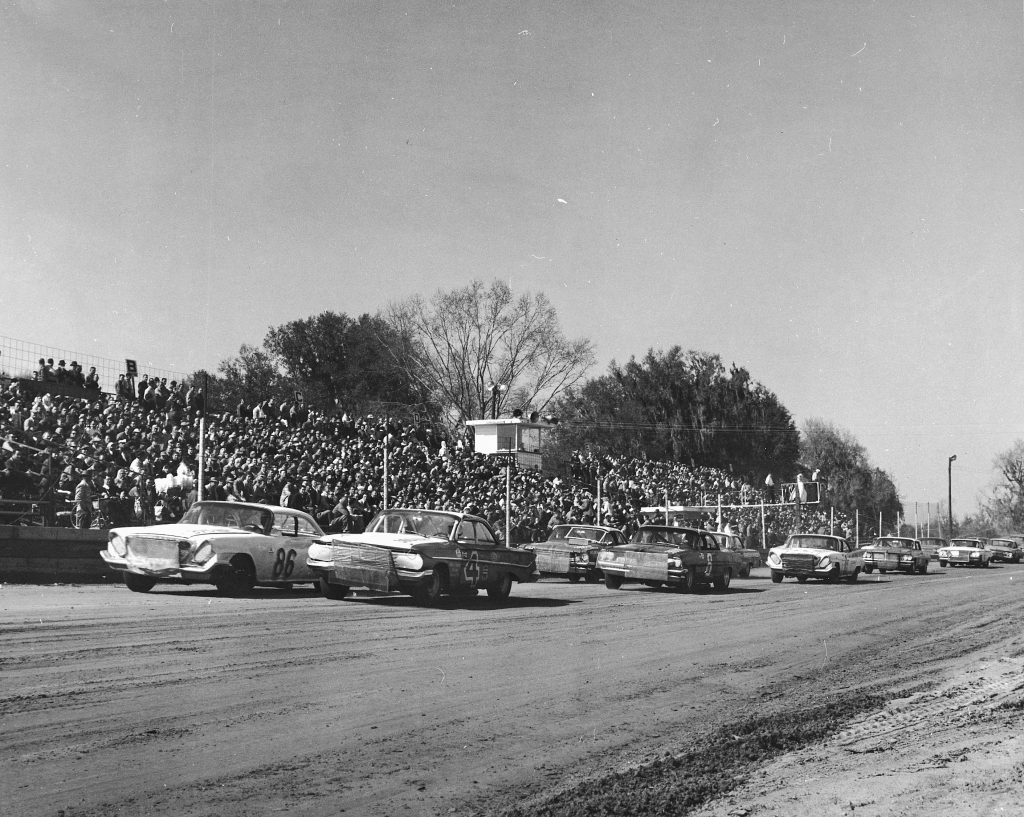
Photo from NASCAR Research & Archives Center via Getty
Images.
According to Racing Reference, 3,500 fans showed up, but more
impressive to me was the fact that 23 race cars were on hand. Most were
so-called independents, but that was the norm for 200-lappers at the time.
Petty Enterprises had two cars, with Richard taking the win and Maurice
coming home fourth. David Pearson’s Cotton Owens Dodge and Ned
Jarrett’s Burton-Robinson Ford rounded out the factory-connected cars.
Those four had won more than two-thirds of all the races 150 miles or
shorter throughout the season, with most of the rest going to other factory-
affiliated drivers making occasional forays into the lesser events.
I’ll give a shout-out to Mitch Walker, about whom I know nothing except that
he made his only career GN/Cup start that day, driving a borrowed car to
11 th place (last among cars running at the finish), 26 laps behind King
Richard. What a story to tell the grandkids.
I should note a couple of things here. First, for about 10 years in the ‘50s
and ‘60s, Bill France ended the GN/Cup season in late October or early
November but then continued to schedule races, which became part of the
NEXT season’s standings, so all the December events (with one exception
I’ll mention later) are part of the next year’s records.
Also, there were actually two December 1963 races in the 1964 season.
Savannah gets the distinction of being the latest ever run, but the earlier
race, on December 1 in Jacksonville, Florida, will forever live on as Wendell
Scott’s sole GN/Cup win in his hopelessly uphill struggle to be a Black
racer succeeding in the NASCAR (and world) of his day.
The next-to-latest-in-the-year GN/Cup race also was the last race we’ve
seen in December, when an astounding 49 cars started a 500-miler at
Texas World Speedway on December 12, 1971. This race had been
postponed from December 5, so its status is accidental.
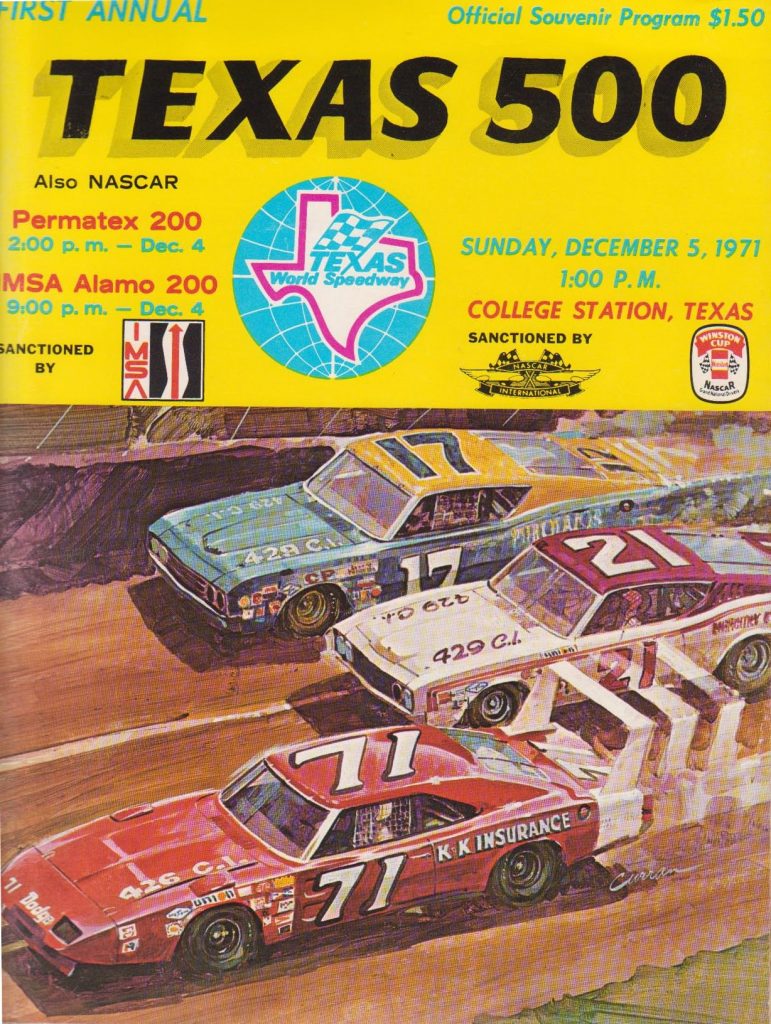
5 race date. Copied from Speedwayandroadracehistory.com.
Now this was the last season before the so-called “modern era” without
those little 200-lappers at Savannah and elsewhere, but that really had little
bearing on this race, although the elimination of the little races maybe
helped move the Texas date up a month the next year (with attendance
increasing from 18,600 to 33,000, per Racing Reference). That seemingly
was a good move, although not enough to save the speedway, which is
slowly disappearing from the landscape down in College Station.
Richard Petty won that 1971 Texas 500 over teammate Buddy Baker (with
my shoutout going to fellow Richmond area resident Bill Dennis, who came
home fifth in Junie Donlavey’s Ford). All kinds of people were in the race,
including singer Marty Robbins and English road-racing star Jackie Oliver,
both DNFs, unfortunately for them. Interestingly, A.J. Foyt’s Chevy
dealership sponsored Benny Parsons, but it wasn’t enough to keep
Benny’s engine in one piece.
Ironically, the third-to-latest-in-the-year event ever was the first GN/Cup
event run in December. It took place on December 11, 1955 (the practice of
counting late-year races toward the next season had started the previous
year, but this was the first THAT late), at Palm Beach Speedway in West
Palm Beach, Florida, a track that played a significant role in NASCAR for a
few seasons.
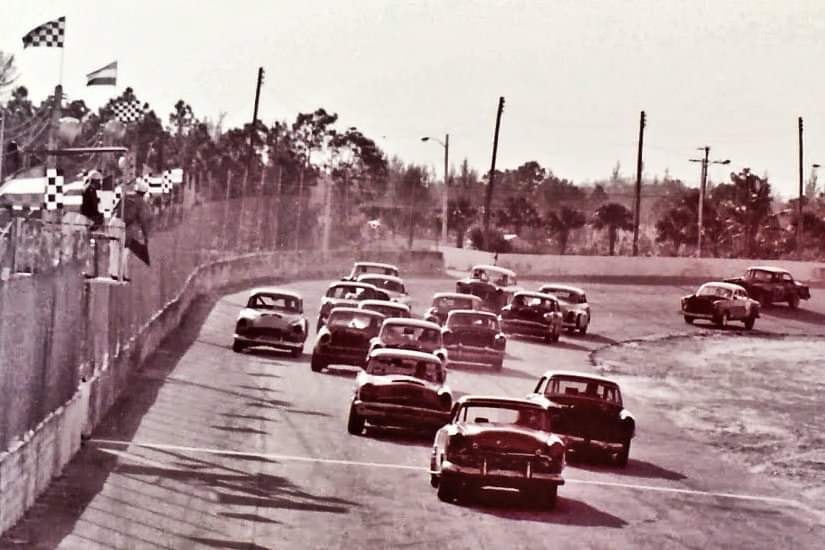
Speedway Facebook page.
Herb Thomas was the winner, but he wasn’t the story, having finished third,
a lap back of the leader, Joe Weatherly. After taking the checkered flag,
Weatherly was disqualified for having an illegal engine. That should have
given the win to Jim Reed, but he, too, was disqualified, and Thomas
ended up with the trophy.
Between 1954 and ’56, a total of five Grand National winners were
disqualified (those facts were dredged up a couple of years ago when
Denny Hamlin was DQ’d after winning at Pocono), but the December ’55
race at W. Palm Beach was the only time when the top two both bit the
dust.
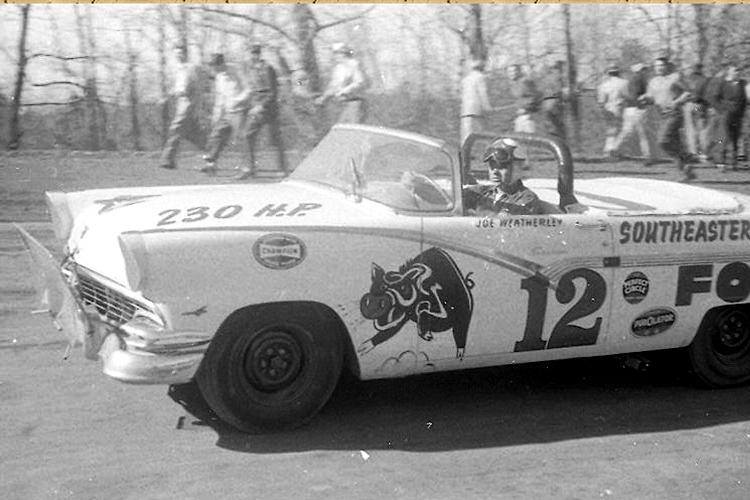
article with just a mention of him being on the “naughty” side of
Santa’s naughty-or-nice list. Here he is in a convertible version of the
Fords he was driving back in that era. Photo from Fantasy NASCAR
Racin’.
Here’s an addendum that you can do with as you will: Al Keller ended up
finishing second behind Thomas in December, and when the NASCAR
stars-‘n’-cars returned to West Palm Beach less than four months later, in
March 1956, he crossed the start-finish line first, only to be disqualified
himself for an engine infraction, giving the win to Billy Myers.
That was the last GN/Cup race ever run at Palm Beach Speedway.
One more Palm Beach note, though. NASCAR had no really late-season
events in the first two seasons of the Strictly Stock (’49) and Grand
National (’50) division, but there were four November races in 1951, and in
’52, Palm Beach Speedway ran both in January and November, the first
and last (34 th ) races of the year. Two years later, Bill France decided to tag
those late-year events onto the next year’s schedule.
One last goofy schedule note: 1969 was the year NASCAR scrapped the
practice of adding late-year events onto the next season, so it was the only
year with a December race near the beginning of the year (the late-year ’68
races counted towards ’69) AND a December race at the end of the same
season. The end-of-year (1969) event was that annual trip to Texas World
Speedway; the very early race (run in ’68 to count for ’69) was run on
December 8 at Montgomery (Ala.) Speedway. For the record, Bobby Allison
was the winner over Richard Petty in Alabama, and Bobby Isaac was the
Texas victor over Donnie Allison.

Since I attended none of these races, I can’t tell you if they were
memorably great or duds, but they did give a good number of people a
chance to see a race in December (although without TV coverage,
unfortunately), and I’m all in favor of that.
Thanks to FLORacing and other outlets, we now have more December
racing to watch, as long as we’re not wedded to the NASCAR stuff we
watch while complaining about it. Hope that’s a trend that continues and
grows.
FRANK’S LOOSE LUG NUTS
I’m not sure I understand all these new pronouncements from Daytona
Beach, but the most recent one seems to mean NASCAR will start
compensating drivers (in some way) for being positive representatives for
the sport (and its owners). Some sources seem to indicate that drivers are
making less money then they did 15-20 years ago, so maybe this is a way
to fatten those fallen-on-hard-times bank accounts.
I mostly understand. Sponsor commitments have taken drivers away from
the old general public appearances, and at the height of its popularity,
NASCAR stars could draw too many fans to make most venues work.
Back in the day, somebody was always at Richmond Ford the day before a
NASCAR race, and the more affordable teams might end up at a gas
station or local diner. By the peak of NASCAR’s popularity, you might get a
show car, but the driver was in a VIP suite somewhere.
If this helps create a balance, I don’t see a down side.
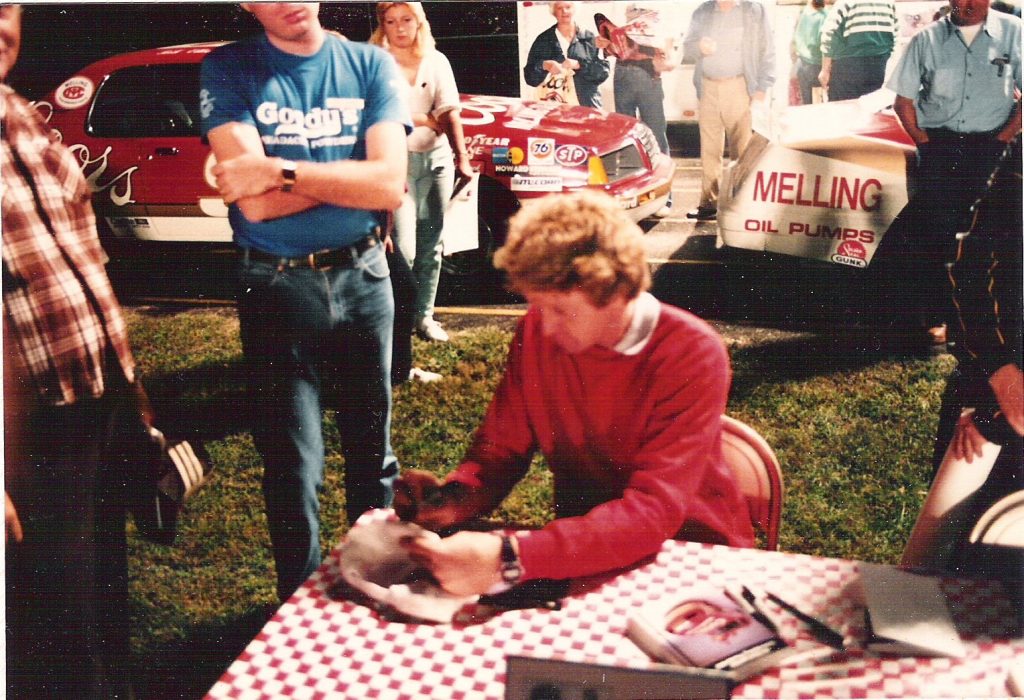
their heroes autographs were more likely to remain fans – maybe that’s
why Bill Elliott won Most Popular Driver so often. We might want to get
back to that. Photo by John Walczak, copied from the Crittenden
Automotive Library website.
This has nothing to do with racing, but the other day I saw a fully
decorated yard with a modest sized Mary & Joseph standing over a
manger. The closest inflatable certainly added to the traditions of the
season: He was born in a manger in a stable, surrounded by donkeys,
cows, sheep, and a Grinch.
Have fun this Christmas, but remember why we celebrate, and don’t let the
Grinch take away either activity.
Frank Buhrman
Photo Credit (cover): Reddit



Back in the day we sure looked forward to seeing Ned, David & Richard on Saturday before Sunday Richmond races at local car dealerships along with their race used vehicles still covered in red clay from Friday night’s Hickory race. That was the prelude to our checking out the Saturday night parking lots for race cars at Richmond Auto Court where the independents stayed then on to the Holiday Inn for a peek at the factory team cars on trailers behind little bob trucks. Perhaps if we were younger we could promote a December New Orleans New Year’s Eve race in the Super Dome as a prelude to the Sugar Bowl.
Have you seen video from these dirt late model races at the dome in St. Louis (which the public financed for an NFL team that promptly left town)? That shows it can be done. I saw midget cars race in Atlantic City 50+ years ago, but with the ventilation systems of those days, you couldn’t see across the track for the fumes by the end.
Went to motorcycle races in 1972 at Richind Coliseum. Same fumes problem.